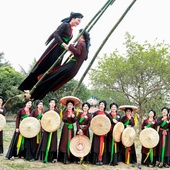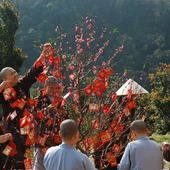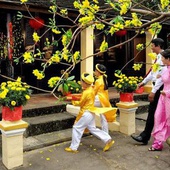Vietnamese Traditional Calligraphy During Tet
Tet holiday is undoubtedly the most important and anticipated event of the year in Vietnam. During Tet, a variety of meaningful traditional customs are practiced, and calligraphy hanging stands out as one of the most beautiful.
This custom not only reflects the Vietnamese people's respect for knowledge but also helps to preserve a centuries-old activity. The meaningful characters inscribed on special paper symbolize good fortune and have served as objects of worship for thousands of years in Vietnam.
The Origins of Calligraphy Giving
Calligraphy giving is a unique traditional custom in Vietnam, originating from the art of beautiful writing. While the exact origins of this tradition remain unclear, its cultural significance is universally acknowledged.
 Photo @example.com
Photo @example.com
Centuries ago, during the feudal era in Vietnam, literature and scholars were highly revered, and obtaining a piece of their handwriting was considered a great honor.
Moreover, receiving calligraphy is viewed as a way of attracting good luck as the new year begins. Therefore, the honor of acquiring a scholar's calligraphy is deeply cherished.
The Hidden Meanings and Values
In the past, when Vietnam's formal writing system utilized Han and Nom characters, the highest respect was afforded to knowledge and scholarship. Mastering beautiful handwriting was an essential quality for those hoping to be esteemed in academic circles. Scholars proficient in this art were indeed celebrated throughout the nation.
 Photo @traditionaltet
Photo @traditionaltet
Tet is a prime opportunity for people to visit scholars and request parallel sentences, believed to bestow a portion of the scholars' knowledge and fortune to their homes and families.
People often seek specific characters that encapsulate their hopes and dreams for the new year, such as Phúc (Happiness), Lộc (Wealth), Thọ (Longevity), Đức (Virtue), Trí (Wisdom), or Tài (Talent). These characters are then displayed on walls as reminders of their aspirations for the coming year.
Nguyen Van Thanh, a renowned calligrapher, shared, “I find joy in hearing from those who received calligraphy from me, telling me that their wishes came true thanks to the characters they hung in their homes.”
Vietnamese calligraphy is even more profound when different connotative characters combine to create new meanings. For instance, "Phúc" is often paired with "Đức" to form "Phúc Đức," implying that the happiness derived from charitable acts (Đức) contributes to one's overall fortune (Phúc).
Legend has it that a person who casually passes by and is gifted a piece of calligraphy by a calligrapher has been recognized as a virtuous individual. This accolade bestows a year of blessings and fulfilled wishes upon both her and her family.
The Enduring Value of Calligraphy Giving
Vietnamese calligraphy, like calligraphy giving, faced challenges during the decline of the feudal system and two prolonged wars against French and American forces. The introduction of modern Vietnamese script, derived from Latin characters, led to a decline in the traditional Han and Nom scripts, causing ancient styles and practices like calligraphy hanging to be overlooked.
 Photo @example.com
Photo @example.com
Despite its waning prominence, the image of an elderly scholar meticulously inscribing elegant black characters on red paper continues to resonate deeply within the hearts of the Vietnamese through generations.
This imagery holds a prominent place in literature, notably in the poem "Ông Đồ" (The Old Scholar) by Nguyen Dinh Lien, reflecting on the theme of being forgotten:
"Every year, peach blossoms bloom.
Once again, the old scholar is seen.
Displaying ink on red paper,
Among the bustling streets of passersby."
The poet Phan Ngoc noted, “Upon entering a traditional Vietnamese home, the first attractions are the parallel sentences, laudatory writings, and lacquered boards that remind us of our ancestors' traditions. Why is the hallmark of Vietnamese culture not magnificent architecture but script? Because it is ingrained in our hearts and is an integral part of Vietnam’s soul.”
If you choose to visit Vietnam during this Lunar New Year, immerse yourself in the vibrant local atmosphere by visiting calligraphers at Văn Miếu (Temple of Literature) in Hanoi. Seek out the script you love, and wait to see if your wishes unfold throughout the year!

Folk Games During Tet Holidays
In the country area, Tet is often a holiday to celebrate with games, folk singing and village feasts. Get to know some of the most popular communal games during Tet holiday.

Visiting Pagodas On New Year Days
Together with the festive atmosphere Tet brings to Vietnam every year, the event also the best time of the year for Vietnamese to show their religious belief and traditional custom. Among them, visiting pagodas on the first days of the year has long been a lofty tradition.

Do and Don't When Xong Dat
Tet Nguyen Dan- the biggest festival of the year- plays an extremely essential role in Vietnamese’s beliefs and culture. Among many complicated religious rituals performed in this occasion, “xong dat” (first visit to a home in a year) is believed to decide the fortune of the host for the whole year.











